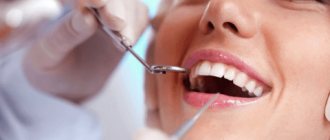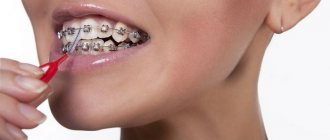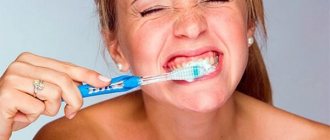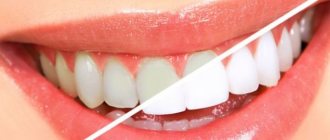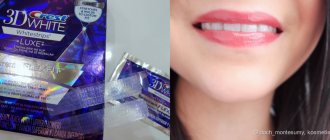Everyone wants to have shiny, snow-white teeth.
However, the prices for professional whitening treatments in a dental office may not be affordable for everyone.
A modern alternative has become special strips that allow everyone, without leaving home, to make their smile brighter and whiter in the shortest possible time without harming the enamel.
General information about the product
Whitening strips or strips (from English strips) are products for home teeth whitening. They consist of two parts of dense material (film), between which there is a layer of gel with active brightening components - hydrogen peroxide or carbamide peroxide. Each row of teeth has its own strip. It will not be possible to whiten all teeth with such means, since the structural features of the human dental system do not allow making long stripes, covering the entire row. Otherwise, the risk of burning the mucous membranes or swallowing the active gel increases many times over. Therefore, they are glued only in the “smile zone” - on the 6-8 front teeth.
On a note! Most manufacturers package 2 strips per use in a sachet (small sealed bag). The long strip is intended for the upper row of teeth, it is marked as “upper”, the short strip is for the lower row, it is marked “lower”.
The whitening course is designed for a certain number of days - 7, 10, 14, or 28. It all depends on the effect of the strips - extra-strong ones are used for fewer days, and gentle ones are designed for 2-4 weeks. As a rule, 1 box of strips is 1 course, i.e. the box will contain the required number of sachets. Manufacturers themselves, as well as dentists, do not recommend repeating whitening courses more than 1-2 times a year.
What effect to expect
According to user reviews, the effect becomes noticeable after 3 sessions, and lasting results can be achieved after 10-14 days of regular procedures. With the help of such strips, you can make the enamel whiter by 1-6 tones - it all depends on the intensity of exposure to the brightening gel and the duration of the course. 1. An activator gel with a low concentration of hydrogen peroxide whitens gradually, usually by 1-4 tones. Products with a high content of active ingredients offer a faster and more pronounced effect - 5-7 tones.
When bleaching with strips, you can achieve lightening of up to 5-7 tones.
How whitening strips work
Whitening strips[1] work on a chemical principle and are one of the most common methods of whitening at home and in dentistry. The bottom line is that after gluing the strips, the active components of the bleach - hydrogen peroxide or carbamide peroxide - begin to interact with the air, saliva in the mouth, soft plaque and pigments on the enamel. The oxidation process starts, as a result of which the darkened areas lighten. Moreover, the active substances work not only on the surface of the teeth, but also penetrate the enamel, whitening it by 2-5 tones. This is the advantage of strips over whitening toothpastes with a high RDA (abrasiveness) index - the latter can whiten teeth only on the surface.
Causes and consequences of darkening of tooth enamel
Discoloration is a fairly common phenomenon. Its detection is a direct signal notifying that you are in danger. As a rule, the cause of plaque and darkening is:
- Failure to comply with hygiene rules, resulting in the accumulation and compaction of plaque from food debris and bacteria;
- Smoking. The resinous substances contained in the smoke first change the tone, and later completely turn the smoker’s teeth dark brown;
- Abuse of wines and bright juices, herbal tinctures, black tea, coffee. Natural and synthetic food dyes eat into enamel quite easily;
- Sweets. The consequence of excessive consumption of sweets can be a carious process that changes the optical density and color of the affected tooth;
- Excess fluoride. Drinking drinking water with a high content of this chemical element can cause not only aesthetic discomfort, but also endemic fluorosis - a rather serious disease;
- Poor quality treatment. Some substances included in outdated filling materials significantly change color after procedures;
- Injury. Damage to the neurovascular bundle instantly changes the shade, and the consequence of tissue breakdown will inevitably be complete darkening;
- Antibiotics and medications. Taking certain medications by pregnant women contributes to the accumulation of harmful substances in the developing buds of the fetal teeth, which threatens the unborn child with an unpleasant enamel color;
- Diseases and hereditary diseases. Unfortunately, in such cases, teeth whitening is not effective; therapeutic or orthopedic treatment will be required;
- Age-related changes. Aging of fabrics changes not only the shape and structure, but also the color.
It is necessary to realize that darkening of the enamel, regardless of the cause, will inevitably lead to more serious problems. Pathogenic bacteria thrive in plaque, where a favorable environment is created for the destruction of diseases that contribute to destruction. Often, darkening is followed by caries and the loss of one or more teeth.
Rules for use at home
How to use teeth whitening strips? The use of whitening strips is carried out only at home, and there must be a supply of clean water (at least 1 glass), it will be needed after using the bleaching agent. Each manufacturer provides their products with detailed instructions, which you must read before use. The features of using different strips differ little from each other and include the following steps:
- brushing your teeth 60-30 minutes before the procedure: it is better not to use a brush immediately before use, because you can scratch your gums a little, and then peroxide will get into the wound and cause irritation,
- you need to take the top strip and peel off the film on one side: this will reveal the inner layer of the whitening gel,
- the strip is applied to the dentition flush with the gum and pressed tightly, with the side with the gel facing the enamel (be careful),
- the free lower part of the strip is folded onto the back side of the dentition and is also pressed tightly,
- the next strip (short) is glued to the bottom row by analogy: the order of gluing may be different - first the bottom, then the top, as indicated by the manufacturer,
- you need to wait a while for the active substances to act,
- remove the strips and rinse your mouth several times with clean water, brush your teeth with a soft-bristled brush.
Gluing is best done with clean, dry hands in a well-lit room. The presence of a mirror is mandatory for the first 3-4 uses.
Waiting time on teeth
How long should I keep teeth whitening strips on? This information should also be reflected in the instructions. Because even within one brand there are several types of strips - some need to be kept for 15-30 minutes (for example, Crest 3D White), others for 60 minutes (for example, Blend-a-med 3D White Luxe). You can reduce the exposure time if unpleasant sensations appear, but you absolutely cannot increase it - this can ruin your teeth.
“I read a lot of good reviews on some popular dental strips. Well, I decided to try it, because the pastes didn’t help much. I ordered some of the most expensive ones so that it would definitely work. And I kept it for an hour, as it was written on the package. But the result turned out to be like paste. Overall, I wasn't impressed. I went to the dentist, thinking maybe the clinic would help. But the doctor said that my teeth are naturally yellow and no amount of whitening will really help.”
Victor, review from gidpozubam.ru
Important application details
Remember that, firstly, the whitening gel contains an aggressive chemical - hydrogen peroxide (albeit in a small concentration), and secondly, after the procedure, the teeth lose part of their natural protective film and they need time to recover. Given these features, the following rules must be observed:
- after brushing your teeth and before the whitening procedure, you can’t eat anything, you can only drink plain water,
- throughout the course you need to switch to a “white diet”: exclude brightly colored foods and drinks, black coffee, strong tea, berries,
- quit smoking or reduce the number of cigarettes to a minimum, because the enamel may darken again,
- do not expose your teeth to extreme temperatures, and also avoid combinations of hot and cold: for example, do not drink ice cream with a hot drink,
- It is not recommended to use bright lip cosmetics or toothpaste with dyes with an abrasiveness higher than 70-100 RDA,
- when the strips are glued to the teeth, it is not recommended to drink, eat, or talk a lot to prevent ingestion of the whitening component: although some manufacturers indicate that all these actions are allowed with their strips, dentists do not consider them completely safe,
- After the procedure, you can drink water, you cannot eat for 2 hours,
- strips are used once, after which they must be thrown away,
- Do not leave sachets or used strips within reach of children or pets.
You should not swap stripes – i.e. do not stick a short one on the top row and a long one on the bottom row. And the point is not at all that the whitening gel will be poorly distributed, but that the strips will stick much worse. After all, they are made taking into account the curves and height of the dentition.
Good to know! Before whitening, it is recommended to undergo professional oral hygiene to remove accumulated stone and plaque. Otherwise, the teeth may whiten unevenly (there will still be dark areas and “growths” of stone near the gums). If your teeth hurt after whitening strips, then you definitely need to undergo remotherapy - strengthening the enamel. In general, remineralization should be carried out in every good clinic after professional hygiene.
What types of whitening strips are there?
The range of brightening products for home whitening is constantly expanding, and today you can purchase a kit for a snow-white smile in almost every pharmacy. This standard set usually includes 2 films - for each jaw. It should be noted right away that this technique is designed to treat only the smile zone, so it is unlikely that it will be possible to lighten the back teeth.
So, currently on pharmacy shelves you can find the following types of whitening strips:
- delicate - aimed at people with increased sensitivity of enamel and, accordingly, its acute susceptibility to temperature changes in food and drinks, sour, sweet foods,
- standard is the best option for people without severe dental problems, with healthy teeth and gums,
- enhanced action - used mainly for emergency elimination of bacterial plaque and urgent lightening of enamel. Such kits contain an activator with a high concentration of the active substance,
- supporting – indicated to consolidate and prolong the achieved effect.
There are also certain types of strips that completely dissolve - there is no need to remove them at the end of the session. However, more often than not, manufacturers still produce strips with a removable film designed to protect the mucous membrane from chemical irritation. There are also options for quick and long exposure. The first offer an almost instant effect, however, the side effects of such bleaching can be much greater.
How many times a day can you use the strips?
As a rule, strips are used once a day. Moreover, most manufacturers recommend whitening in the evening - for example, an hour after dinner. So that the active components remaining in the enamel layer have a better effect. And try to carry out the procedure in the following days at a certain time of day. Some strips are suitable for twice daily use – morning and evening. In this case, manufacturers must indicate this information in the instructions.
How to Choose the Best Whitening Plates
Before purchasing a kit, you should make an appointment with your dentist and undergo a preventive examination. The doctor will assess the condition of your enamel and recommend the most suitable remedy specifically for your case. When choosing strips, dental experts advise considering the following characteristics:
- the concentration of the active component - the higher it is, the faster and more noticeable the result will be, however, the potential danger to teeth will also be higher,
- principle of operation, duration of one session and the course as a whole - choose based on your own preferences,
- packaging tightness,
- company and country of origin,
- best before date,
- price category.
Today on the Internet you can find a lot of real reviews about a variety of brands of whitening strips, and on thematic forums you can always discuss certain kits with those who have already tested their effectiveness and safety from their own experience. However, in the question of which product is best for you, the recommendation of a specialist should be decisive.
